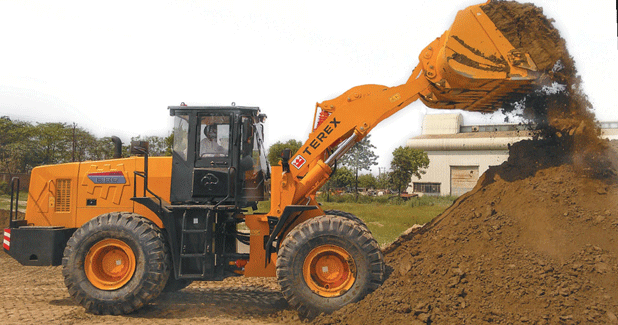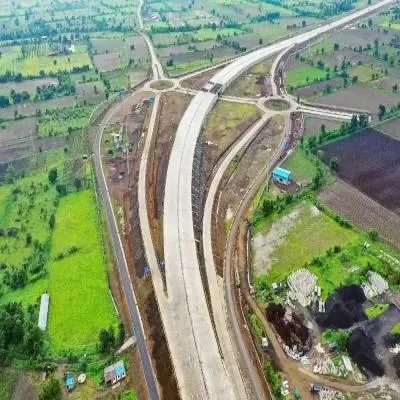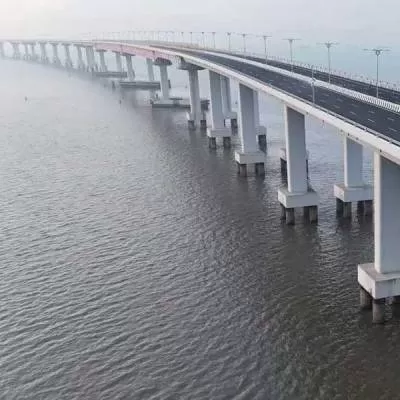- Home
- Infrastructure Transport
- ROADS & HIGHWAYS
- Motoring ahead

Motoring ahead
Demand for medium and heavy commercial vehicles (MHCV) has been increasing incessantly, and is expected to grow further as projects, to extend the road network get off the ground. Bright prospects for the automobile industry have almost every tyre manufacturer planning to raise production levels.
¨Demand for heavy vehicle tyres alone will touch 25 million in 2015, a steep growth from the 125 million tyres produced across categories in FY2012,¨ according to Shushmul Maheshwari, CEO, RNCOS, a research organisation. Maheshwari expects future growth to be led by strong demand from original equipment manufacturers (OEMs). In the near term, however, producers will have to contend with rising raw material costs and limited growth. ¨As a result, manufacturers face a tough call on whether to sell at suboptimal prices or absorb cost hikes,¨ says Maheshwari.
¨Growth in the commercial segment is still in low single digits as economic recovery has yet to gain momentum,¨ observes Arnab Banerjee, Executive Director, Operations, CEAT Ltd. ¨After the pace of economic activity picks up as expected in six to 12 months, we expect strong growth in the MHCV space.¨
Industry woes
Currently, one of the biggest concerns of the tyre industry is lower import duty on tyres vis-a-vis import duty on raw materials used in tyre-making.
¨While import duty on tyres is 10 per cent, it gets cut to 8.6 per cent for tyres from China because of an existing Asia Pacific agreement,¨ notes Maheshwari. ¨Duty on imported tyres can be as low as between 6 per cent and 8 per cent under various FTAs,¨ says Vikram Malhotra, Marketing Director, JK Tyre & Industries Ltd. On the other hand, ¨Duty on natural rubber, our key raw material has recently been increased to 25 per cent,¨ explains Satish Sharma, President, Asia Pacific, Middle East & Africa, Apollo Tyres Ltd.
This anomaly has created unfair competition between tyres made in India and Chinese tyres. ¨Tariffs on raw materials like natural rubber are having an adverse impact on the competitiveness of the domestic industry,¨ agrees Banerjee. More competitively priced Chinese products have flooded the Indian market, despite the fact that most are unbranded and adhere to no safety norms.
¨Chinese imports have infiltrated the radial tyre market with a 20 per cent price difference for bus and truck radials. They currently account for 70 per cent of imports in the truck and bus sector,¨ says Maheshwari. ¨Chinese tyre imports constitute 34 per cent of the truck or bus tyre replacement market and 44 per cent of that of car tyres,¨ adds Malhotra. According to him, Chinese manufacturers and their dealers resort to all kinds of malpractices including under-invoicing and wrong description of tyres to bring them to the Indian market. ¨Low-priced Chinese tyres have a significant presence and are growing fast in the passenger car and truck radial segment,¨ in Banerjee.
The US government has imposed a strict anti-dumping duty on Chinese tyres to protect its domestic industry. The Indian tyre industry would like the Indian government to follow suit.
User´s choice
Cheap imports are definitely hurting the domestic tyre industry; however, this is applicable more in the replacement market than with vehicle makers, observes Sharma.
¨While the first purchase will be based on brands, subsequent purchases will be based on a set of governing factors that include average tyre life, price, after-sales and service network,¨ says Kaushik Madhavan, Head-Automotive & Transportation Practice, Frost & Sullivan. Essentially, user experience more than brand, determines repeat business in the heavy commercial vehicles tyre market.
Construction equipment manufacturers stick to reputed brands as their clientele value quality over mere lower cost. ¨Chinese tyres have a lower operating life; our customers are well aware of the cost benefit advantage and demand the best Indian tyres for their machines,¨ says Rajesh Shrivastava, General Manager, Marketing, Terex India. ¨The loss of tyres can stall the whole machinery during its working shift and the resultant loss has a cascading effect.¨
¨We prefer Indian-made tyres for the local market as these suit Indian geographical requirements,¨ says Ajay Aneja, National Head, Sales & Export, CASE India. ¨Our Indian clientele looks upon Chinese-made tyres as being of low quality and unsafe, so we don´t use them.¨
Radial domination
Radialisation is the biggest trend in the tyre industry. Radial technology is rapidly gaining preference among truck and bus operators for benefits such as fuel savings, longer life, puncture resistance, comfort and safety. ¨Demand is veering towards quality tyres offering high performance like radials,¨ agrees Maheshwari.
¨Truck and bus radial is the way of the future as it delivers fuel - efficiency, safety and longevity benefits that help drive the fleet owner´s costs down,¨ says Mohan Kumar, Commercial Director-Passenger Car, Truck & Bus, Michelin India. ¨Michelin is committed to drive the radialisation efforts for truck and bus tyres in India.¨ As a result, today, radialisation in the domestic truck/bus segment stands at 32 per cent, according to Malhotra. While this trend slowed down a little last year, an outcome of the slowdown in infrastructure development and economic activity, Malhotra expects 35 per cent radialisation by the end of this fiscal and 65 per cent in the next two years.
¨Radialisation, especially in the MHCV space, is happening at a fast clip,¨ says Banerjee. ¨In the OEM segment, radialisation has already touched the 60 per cent mark. In the replacement market, the radial tyre potential is 30 per cent plus and is expected to cross 35 per cent by the end of FY16.¨
Not surprisingly, radialisation is driving major capacity expansions. ¨Increased demand for Apollo´s truck bus radials has prompted us to invest Rs 1,500 crore in our Chennai facility to expand the capacity of these tyres from 6,000 per day to 9,000 per day,¨ says Sharma.
Green on the road
Green or eco-friendly tyres are made of epoxidised natural rubber. By ensuring optimum traction with substantial reduction in rolling resistance, green tyres improve fuel economy and cut emissions. Although they have been around since the 1990s, owing to higher manufacturing costs, eco-friendly tyres were put on the backburner until recently. Today, however, major players are focusing on offering better choices in this segment because awareness of green tyres has grown.
¨Our R&D team is working towards developing tyres with low rolling resistance, better fuel efficiency and using environment-friendly raw materials,¨ shares Sharma. Indeed, R&D is the key to growing this segment. ¨Building up green tyres will take time because of high pricing and low demand,¨ says Banerjee. ¨Growth could accelerate if new products offer tangible benefits in the area of fuel-efficiency at competitive prices.¨ And, Maheshwari adds, ¨Green tyres like Bridgestone´s Ecopia, Pirelli´s Cinturato and Goodyear´s Fuel Max, all available for commercial vehicles, are fast emerging a benchmark for the industry´s competitiveness.¨
Branding and service
Focusing on branding and strengthening their distribution and service network has helped leading industry players improve their market share.
Tyre major Michelin India has tremendously expanded its network of Michelin Truck Service Centres, one-stop shops offering end-to-end tyre-related services for trucks and buses. Each centre is equipped with state-of-the-art facilities, including a computerised alignment machine, tyre repair machine, tyre fitment and rotation. These centres also aim to reach out to customers and educate them about choosing the right radial tyre. According to Kumar, ¨Highways carrying heavy traffic demand one-stop truck service centres where transporters can obtain professional service using state-of-the-art equipment and world-class products.¨
With action on all fronts, the tyre industry can´t but motor ahead!
Quick Bytes
- Demand for MHCV to grow further.
- Growth in the commercial segment is still in single digits.
- User experience more than brand, determines repeat business in the heavy commercial vehicles tyre market.
- Radialisation is the biggest trend in the tyre industry.
Which tyre for what application?
Choosing the right tyre for any equipment is critical as it has a direct impact on safety and energy-efficiency or productivity. So, which tyre is best suited for construction and mining applications?
¨We use tyres specifically developed for off-highway industrial applications,¨ says Ajay Aneja, National Head, Sales & Export, CASE India. ¨Must-haves are great traction on the drive wheels, best performance on and off the road, excellent durability and cut and chip resistance. Industrial tyres offer greater traction with a deeper tread, so are better suited for slightly slippery clayey soil. Heavy-duty tyres are more durable because of their higher ply rating but have a shallower tread. In areas around crushers where tyres are more prone to cuts, customers prefer heavy-duty tyres.¨
¨Tyre configration on Terex machines depends on the application for which the machines are positioned,¨ explains Rajesh Shrivastava, General Manager, Marketing, Terex India. Whereas high-traction rear tyres are preferred for agricultural applications, the impact resistance strength of the tyres is the critical factor in industrial and mining applications. ¨Mining applications mandate tyres with higher ply rating (16-20 PR) than the standard traction type tyres,¨ he adds.
¨Our tyre selection is primarily based on vehicle application, load carried and terrain of the duty cycle,¨ says the spokesperson of Daimler India Commercial Vehicles. ¨Typical preference is radial tyres for on-highway application for rigids and tractors. Cross-ply or mining pattern tyres best suit off-highway applications for tippers and construction vehicles.¨
- MHCV
- Motoring
- Shushmul Maheshwari
- RNCOS
- OEMs
- Arnab Banerjee
- CEAT Ltd
- Vikram Malhotra
- JK Tyre & Industries Ltd
- Satish Sharma
- Apollo Tyres Ltd
- Tyre
- Kaushik Madhavan
- Frost & Sullivan
- Rajesh Shrivastava
- Terex India
- Ajay Aneja
- CASE India
- Mohan Kumar
- Michelin India
- Bridgestone
- Ecopia
- Pirelli
- Cinturato
- Rajesh Shrivastava
- Terex India
Good times lie ahead for tyre makers in India - indeed, great times if the government comes down heavily on tyre imports. Demand for medium and heavy commercial vehicles (MHCV) has been increasing incessantly, and is expected to grow further as projects, to extend the road network get off the ground. Bright prospects for the automobile industry have almost every tyre manufacturer planning to raise production levels. ¨Demand for heavy vehicle tyres alone will touch 25 million in 2015, a steep growth from the 125 million tyres produced across categories in FY2012,¨ according to Shushmul Maheshwari, CEO, RNCOS, a research organisation. Maheshwari expects future growth to be led by strong demand from original equipment manufacturers (OEMs). In the near term, however, producers will have to contend with rising raw material costs and limited growth. ¨As a result, manufacturers face a tough call on whether to sell at suboptimal prices or absorb cost hikes,¨ says Maheshwari. ¨Growth in the commercial segment is still in low single digits as economic recovery has yet to gain momentum,¨ observes Arnab Banerjee, Executive Director, Operations, CEAT Ltd. ¨After the pace of economic activity picks up as expected in six to 12 months, we expect strong growth in the MHCV space.¨ Industry woes Currently, one of the biggest concerns of the tyre industry is lower import duty on tyres vis-a-vis import duty on raw materials used in tyre-making. ¨While import duty on tyres is 10 per cent, it gets cut to 8.6 per cent for tyres from China because of an existing Asia Pacific agreement,¨ notes Maheshwari. ¨Duty on imported tyres can be as low as between 6 per cent and 8 per cent under various FTAs,¨ says Vikram Malhotra, Marketing Director, JK Tyre & Industries Ltd. On the other hand, ¨Duty on natural rubber, our key raw material has recently been increased to 25 per cent,¨ explains Satish Sharma, President, Asia Pacific, Middle East & Africa, Apollo Tyres Ltd. This anomaly has created unfair competition between tyres made in India and Chinese tyres. ¨Tariffs on raw materials like natural rubber are having an adverse impact on the competitiveness of the domestic industry,¨ agrees Banerjee. More competitively priced Chinese products have flooded the Indian market, despite the fact that most are unbranded and adhere to no safety norms. ¨Chinese imports have infiltrated the radial tyre market with a 20 per cent price difference for bus and truck radials. They currently account for 70 per cent of imports in the truck and bus sector,¨ says Maheshwari. ¨Chinese tyre imports constitute 34 per cent of the truck or bus tyre replacement market and 44 per cent of that of car tyres,¨ adds Malhotra. According to him, Chinese manufacturers and their dealers resort to all kinds of malpractices including under-invoicing and wrong description of tyres to bring them to the Indian market. ¨Low-priced Chinese tyres have a significant presence and are growing fast in the passenger car and truck radial segment,¨ in Banerjee. The US government has imposed a strict anti-dumping duty on Chinese tyres to protect its domestic industry. The Indian tyre industry would like the Indian government to follow suit. User´s choice Cheap imports are definitely hurting the domestic tyre industry; however, this is applicable more in the replacement market than with vehicle makers, observes Sharma. ¨While the first purchase will be based on brands, subsequent purchases will be based on a set of governing factors that include average tyre life, price, after-sales and service network,¨ says Kaushik Madhavan, Head-Automotive & Transportation Practice, Frost & Sullivan. Essentially, user experience more than brand, determines repeat business in the heavy commercial vehicles tyre market. Construction equipment manufacturers stick to reputed brands as their clientele value quality over mere lower cost. ¨Chinese tyres have a lower operating life; our customers are well aware of the cost benefit advantage and demand the best Indian tyres for their machines,¨ says Rajesh Shrivastava, General Manager, Marketing, Terex India. ¨The loss of tyres can stall the whole machinery during its working shift and the resultant loss has a cascading effect.¨ ¨We prefer Indian-made tyres for the local market as these suit Indian geographical requirements,¨ says Ajay Aneja, National Head, Sales & Export, CASE India. ¨Our Indian clientele looks upon Chinese-made tyres as being of low quality and unsafe, so we don´t use them.¨ Radial domination Radialisation is the biggest trend in the tyre industry. Radial technology is rapidly gaining preference among truck and bus operators for benefits such as fuel savings, longer life, puncture resistance, comfort and safety. ¨Demand is veering towards quality tyres offering high performance like radials,¨ agrees Maheshwari. ¨Truck and bus radial is the way of the future as it delivers fuel - efficiency, safety and longevity benefits that help drive the fleet owner´s costs down,¨ says Mohan Kumar, Commercial Director-Passenger Car, Truck & Bus, Michelin India. ¨Michelin is committed to drive the radialisation efforts for truck and bus tyres in India.¨ As a result, today, radialisation in the domestic truck/bus segment stands at 32 per cent, according to Malhotra. While this trend slowed down a little last year, an outcome of the slowdown in infrastructure development and economic activity, Malhotra expects 35 per cent radialisation by the end of this fiscal and 65 per cent in the next two years. ¨Radialisation, especially in the MHCV space, is happening at a fast clip,¨ says Banerjee. ¨In the OEM segment, radialisation has already touched the 60 per cent mark. In the replacement market, the radial tyre potential is 30 per cent plus and is expected to cross 35 per cent by the end of FY16.¨ Not surprisingly, radialisation is driving major capacity expansions. ¨Increased demand for Apollo´s truck bus radials has prompted us to invest Rs 1,500 crore in our Chennai facility to expand the capacity of these tyres from 6,000 per day to 9,000 per day,¨ says Sharma. Green on the road Green or eco-friendly tyres are made of epoxidised natural rubber. By ensuring optimum traction with substantial reduction in rolling resistance, green tyres improve fuel economy and cut emissions. Although they have been around since the 1990s, owing to higher manufacturing costs, eco-friendly tyres were put on the backburner until recently. Today, however, major players are focusing on offering better choices in this segment because awareness of green tyres has grown. ¨Our R&D team is working towards developing tyres with low rolling resistance, better fuel efficiency and using environment-friendly raw materials,¨ shares Sharma. Indeed, R&D is the key to growing this segment. ¨Building up green tyres will take time because of high pricing and low demand,¨ says Banerjee. ¨Growth could accelerate if new products offer tangible benefits in the area of fuel-efficiency at competitive prices.¨ And, Maheshwari adds, ¨Green tyres like Bridgestone´s Ecopia, Pirelli´s Cinturato and Goodyear´s Fuel Max, all available for commercial vehicles, are fast emerging a benchmark for the industry´s competitiveness.¨ Branding and service Focusing on branding and strengthening their distribution and service network has helped leading industry players improve their market share. Tyre major Michelin India has tremendously expanded its network of Michelin Truck Service Centres, one-stop shops offering end-to-end tyre-related services for trucks and buses. Each centre is equipped with state-of-the-art facilities, including a computerised alignment machine, tyre repair machine, tyre fitment and rotation. These centres also aim to reach out to customers and educate them about choosing the right radial tyre. According to Kumar, ¨Highways carrying heavy traffic demand one-stop truck service centres where transporters can obtain professional service using state-of-the-art equipment and world-class products.¨ With action on all fronts, the tyre industry can´t but motor ahead! Quick Bytes Demand for MHCV to grow further. Growth in the commercial segment is still in single digits. User experience more than brand, determines repeat business in the heavy commercial vehicles tyre market. Radialisation is the biggest trend in the tyre industry. Which tyre for what application? Choosing the right tyre for any equipment is critical as it has a direct impact on safety and energy-efficiency or productivity. So, which tyre is best suited for construction and mining applications? ¨We use tyres specifically developed for off-highway industrial applications,¨ says Ajay Aneja, National Head, Sales & Export, CASE India. ¨Must-haves are great traction on the drive wheels, best performance on and off the road, excellent durability and cut and chip resistance. Industrial tyres offer greater traction with a deeper tread, so are better suited for slightly slippery clayey soil. Heavy-duty tyres are more durable because of their higher ply rating but have a shallower tread. In areas around crushers where tyres are more prone to cuts, customers prefer heavy-duty tyres.¨ ¨Tyre configration on Terex machines depends on the application for which the machines are positioned,¨ explains Rajesh Shrivastava, General Manager, Marketing, Terex India. Whereas high-traction rear tyres are preferred for agricultural applications, the impact resistance strength of the tyres is the critical factor in industrial and mining applications. ¨Mining applications mandate tyres with higher ply rating (16-20 PR) than the standard traction type tyres,¨ he adds. ¨Our tyre selection is primarily based on vehicle application, load carried and terrain of the duty cycle,¨ says the spokesperson of Daimler India Commercial Vehicles. ¨Typical preference is radial tyres for on-highway application for rigids and tractors. Cross-ply or mining pattern tyres best suit off-highway applications for tippers and construction vehicles.¨




















